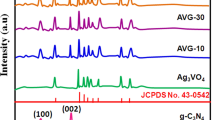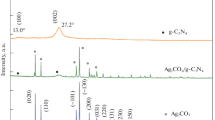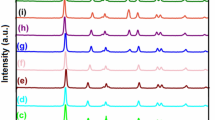Abstract
Nano-heterostructure constructed from Ag3PO4 and TiO2 has been successfully fabricated by the hydrothermal method with 2–10% of Ag3PO4 (X-AT). All the material properties have been investigated using XRD, HR-TEM, FEG-SEM, UV–Vis (DRS), BET surface area, XPS, and PL spectroscopy. The optoelectronic and structural properties have been correlated with materials photocatalytic performance with visible light illumination. XRD implies the formation of anatase and cubic phases of TiO2 and Ag3PO4 nanoparticles, respectively, with average crystallite size in the range of 18–25 nm. The formation of a proper heterojunction is corroborated by HR-TEM image. The addition of Ag3PO4 decreases the band gap from 3.2 for TiO2 to 2.56 eV for 10-AT heterojunction. The photocatalytic reduction of Cr(VI) and deterioration of basic fuchsin were evaluated for the Ag3PO4–TiO2 nano-heterojunction. 50 ppm of Cr(VI) solution is completely reduced into Cr(III) within 75 min of visible light irradiation using 10-AT, whereas the same material takes 120 min for the complete degradation of 10 ppm of basic fuchsin dye solution. Bare TiO2 and Ag3PO4 show insignificant photocatalytic efficiency under similar conditions. The improvement can be attributed to the synergistic effect of diminished charge carrier recombination and increased visible light absorption due to the surface plasmon resonance of the metallic silver nanoparticle and oxygen vacancies.








Similar content being viewed by others
References
Shanker U, Rani M, Jassal V (2017) Degradation of hazardous organic dyes in water by nanomaterials. Environ Chem Lett 15:623–642. https://doi.org/10.1007/s10311-017-0650-22
Enniya I, Rghioui L, Jourani A (2018) Adsorption of hexavalent chromium in aqueous solution on activated carbon prepared from apple peels. Sustain Chem Pharm 7(9–167):9–16. https://doi.org/10.1016/j.scp.2017.11.003
Silveira E, Marques PP, Silva SS, Lima-Filho JL, Porto ALF, Tambourgi EB (2009) Selection of Pseudomonas for industrial textile dyes decolourization. Int Biodeterior Biodegrad 63:230–235. https://doi.org/10.1016/j.ibiod.2008.09.007
Taamallah A, Merouani S, Hamdaoui O (2016) Sonochemical degradation of basic fuchsin in water. Desalin Water Treat 57:27314–27330. https://doi.org/10.1080/19443994.2016.1168320
El Haddad M (2016) Removal of Basic Fuchsin dye from water using mussel shell biomass waste as an adsorbent: equilibrium, kinetics, and thermodynamics. J Taibah Univ Sci 10:664–674. https://doi.org/10.1016/j.jtusci.2015.08.007
Long Y, Li Q, Ni J, Xu F, Xu H (2015) Treatment of metal wastewater in pilot-Scale packed bed systems: Efficiency of single- vs. Mixed-Mushrooms. RSC Adv 5:29145–29152. https://doi.org/10.1039/c5ra02409a
Bhaumik M, Maity A, Srinivasu VV, Onyango MS (2011) Enhanced removal of Cr(VI) from aqueous solution using polypyrrole/Fe3O4 magnetic nanocomposite. J Hazard Mater 190:381–390. https://doi.org/10.1016/j.jhazmat.2011.03.062
Saha R, Nandi R, Saha B (2011) Sources and toxicity of hexavalent chromium. J Coord Chem 64:1782–1806. https://doi.org/10.1080/00958972.2011.583646
Hosseini SA, Talebipour S, Neyestani MR, Ranjan S, Dasgupta N (2018) Graphene oxide MgFe2O4 nanocomposites for Cr(VI) remediation: a comparative modeling study. Nanotechnol Environ Eng 3:10. https://doi.org/10.1007/s41204-018-0039-x
Wani R, Kodam KM, Gawai KR, Dhakephalkar PK (2007) Chromate reduction by Burkholderia cepacia MCMB-821, isolated from the pristine habitat of alkaline crater lake. Appl Microbiol Biotechnol 75:627–632. https://doi.org/10.1007/s00253-007-0862-7
Guo X, Fei GT, Su H, de Zhang L (2011) High-performance and reproducible polyaniline nanowire/tubes for removal of Cr(VI) in aqueous solution. J Phys Chem C 115:1608–1613. https://doi.org/10.1021/jp1091653
Wang CC, Du XD, Li J, Guo XX, Wang P, Zhang J (2016) Photocatalytic Cr(VI) reduction in metal-organic frameworks: a mini-review. Appl Catal B Environ 193:198–216. https://doi.org/10.1016/j.apcatb.2016.04.030
Crini G, Lichtfouse E (2019) Advantages and disadvantages of techniques used for wastewater treatment. Environ Chem Lett 17:145–155. https://doi.org/10.1007/s10311-018-0785-9
Singh J, Kalamdhad AS, Koduru JR (2017) Potential degradation of hazardous dye Congo red by nano-metallic particles synthesized from the automobile shredder residue. Nanotechnol Environ Eng 2:10. https://doi.org/10.1007/s41204-017-0021-z
Dong H, **ao M, Li J, Hu W, Sun X, Liu Y, Zhang P, Che G, Liu C (2020) Construction of H-TiO2/BiOCl heterojunction with improved photocatalytic activity under the visible and near-infrared light. J Photochem Photobiol A 392:112369. https://doi.org/10.1016/j.jphotochem.2020.112369
Naciri Y, Chennah A, Jaramillo-Páez C, Navío JA, Bakiz B, Taoufyq A, Ezahri M, Villain S, Guinneton F, Benlhachemi A (2019) Preparation, characterization and photocatalytic degradation of Rhodamine B dye over a novel Zn3(PO4)2 /BiPO4 catalyst. J Environ Chem Eng 7:103075. https://doi.org/10.1016/j.jece.2019.103075
Kumar A, Raizada P, Hosseini-Bandegharaei A, Thakur VK, Nguyen VH, Singh P (2021) C-, N-Vacancy defect engineered polymeric carbon nitride towards photocatalysis: Viewpoints and challenges. J Mater Chem A 9:111–153. https://doi.org/10.1039/D0TA08384D
Sonu DV, Sharma S, Raizada P, Hosseini-Bandegharaei A, Kumar Gupta V, Singh P (2019) Review on augmentation in photocatalytic activity of CoFe2O4 via heterojunction formation for photocatalysis of organic pollutants in water. J Saudi Chem Soc 23:1119–1136. https://doi.org/10.1016/j.jscs.2019.07.003
Abou-Gamra ZM, Ahmed MA, Hamza MA (2017) Investigation of commercial PbCrO4/TiO2 for photodegradation of rhodamine B in aqueous solution by visible light. Nanotechnol Environ Eng 2:12. https://doi.org/10.1007/s41204-017-0024-9
Gasmalla HB, Lu X, Shinger MI, Ni L, Chishti AN, Diao G (2019) Novel magnetically separable of Fe3O4 /Ag3PO4@WO3 nanocomposites for enhanced photocatalytic and antibacterial activity against Staphylococcus aureus (S. aureus). J Nanobiotechnol 17:58. https://doi.org/10.1186/s12951-019-0485-z
Asadzadeh-Khaneghah S, Habibi-Yangjeh A (2020) g-C3N4/carbon dot-based nanocomposites serve as efficacious photocatalysts for environmental purification and energy generation: a review. J Clean Prod 276:124319. https://doi.org/10.1016/j.jclepro.2020.124319
Abbasi-Asl H, Sabzehmeidani MM, Ghaedi M (2021) Efficient degradation of metronidazole antibiotic by TiO2/Ag3PO4/g–C3N4 ternary composite photocatalyst in a continuous flow-loop photoreactor. J Environ Chem Eng 9:105963. https://doi.org/10.1016/j.jece.2021.105963
Hashem EH, Fahmy A, Abbas A, Tarek M, Mahran B, Ahmed MA (2020) Fabrication of novel AgIO4/TiO2 heterojunction for photocatalytic hydrogen production through direct Z-scheme mechanism. Nanotechnol Environ Eng 5:17. https://doi.org/10.1007/s41204-020-00081-1
Faisal M, Ismail AA, Harraz FA, Al-Sayari SA, El-Toni AM, Al-Salami AE, Al-Assiri MS (2018) Fabrication of highly efficient TiO2/C3N4 visible light driven photocatalysts with enhanced photocatalytic activity. J Mol Struct 1173:428–438. https://doi.org/10.1016/j.molstruc.2018.07.014
Abbad S, Guergouri K, Gazaout S, Djebabra S, Zertal A, Barille R, Zaabat M (2020) Effect of silver do** on the photocatalytic activity of TiO2 nanopowders synthesized by the sol-gel route. J Environ Chem Eng 8:103718. https://doi.org/10.1016/j.jece.2020.103718
Xu JW, da Gao Z, Han K, Liu Y, Song YY (2014) Synthesis of magnetically separable Ag3PO4/TiO2/Fe3O4heterostructure with enhanced photocatalytic performance under visible light for photoinactivation of bacteria. ACS Appl Mater Interfaces 6:15122–15131. https://doi.org/10.1021/am5032727
Cui X, Yang X, **an X, Tian L, Tang H, Liu Q (2018) Insights into highly improved solar-driven photocatalytic oxygen evolution over integrated Ag3PO4/MoS2 heterostructures. Front Chem 6:123. https://doi.org/10.3389/fchem.2018.00123
Liu Y, Fang L, Lu H, Liu L, Wang H, Hu C (2012) Highly efficient and stable Ag/Ag3PO4 plasmonic photocatalyst in visible light. Catal Commun 17:200–204. https://doi.org/10.1016/j.catcom.2011.11.001
Wu C (2015) Facile room temperature synthesis of Ag@AgBr core-shell microspheres with high visible-light-driven photocatalytic performance. J Mater Res 30:677–685. https://doi.org/10.1557/jmr.2015.20
Zhang D, Wang J (2017) In situ photoactivated plasmonic Ag3PO4@silver as a stable catalyst with enhanced photocatalytic activity under visible light. Mater Res 20:702–711. https://doi.org/10.1590/1980-5373-MR-2016-0800
Mousavi M, Habibi-Yangjeh A, Abitorabi M (2016) Fabrication of novel magnetically separable nanocomposites using graphitic carbon nitride, silver phosphate and silver chloride and their applications in photocatalytic removal of different pollutants using visible-light irradiation. J Colloid Interface Sci 480:218–231. https://doi.org/10.1016/j.jcis.2016.07.021
Ali T, Ahmed A, Alam U, Uddin I, Tripathi P, Muneer M (2018) Enhanced photocatalytic and antibacterial activities of Ag-doped TiO2 nanoparticles under visible light. Mater Chem Phys 212:325–335. https://doi.org/10.1016/j.matchemphys.2018.03.052
Taheri ME, Petala A, Frontistis Z, Mantzavinos D, Kondarides DI (2017) Fast photocatalytic degradation of bisphenol A by Ag3PO4/TiO2 composites under solar radiation. Catal Today 280:99–107. https://doi.org/10.1016/j.cattod.2016.05.047
Sheu FJ, Cho CP, Liao YT, Yu CT (2018) Ag3PO4-TiO2-graphene oxide ternary composites with efficient photodegradation, hydrogen evolution, and antibacterial properties. Catalysts 8:57. https://doi.org/10.3390/catal8020057
Ibrahim Shinger M (2015) Simulated Sunlight induced the degradation of rhodamine B over graphene oxide-based Ag3PO4@AgCl. Int J Mater Sci Appl 4:246. https://doi.org/10.11648/j.ijmsa.20150404.14
Sulaeman U, Suhendar S, Diastuti H, Andreas R, Yin S (2020) Short communication: design of defect and metallic silver in silver phosphate photocatalyst using the hydroxyapatite and glucose Indones. J Chem 20:1441–1447. https://doi.org/10.22146/ijc.48647
Yuan Q, Chen L, **ong M, He J, Luo SL, Au CT, Yin SF (2014) Cu2O/BiVO4 heterostructures: synthesis and application in simultaneous photocatalytic oxidation of organic dyes and reduction of Cr(VI) under visible light. Chem Eng J 255:394–402. https://doi.org/10.1016/j.cej.2014.06.031
Denisov N, Yoo J, Schmuki P (2014) Effect of different hole scavengers on the photoelectrochemical properties and photocatalytic hydrogen evolution performance of pristine and Pt-decorated TiO2 nanotubes. Electrochim Acta 319:61–71. https://doi.org/10.1016/j.electacta.2019.06.173
Cappelletti G, Bianchi CL, Ardizzone S (2008) Nano-titania assisted photoreduction of Cr(VI). The role of the different TiO2 polymorphs. Appl Catal B 78:193–201. https://doi.org/10.1016/j.apcatb.2007.09.022
Xu T, Cai Y, O’Shea KE (2007) Adsorption and photocatalyzed oxidation of methylated arsenic species in TiO2 suspensions. Environ Sci Technol 41:5471–5477. https://doi.org/10.1021/es0628349
Ren J, Hu T, Gong Q, Wang Q, Sun B, Gao T, Cao P, Zhou G (2020) Spherical Bi2WO6/Bi2S3/MoS2 n-p heterojunction with excellent visible-light photocatalytic reduction Cr(VI) activity. Nanomaterials 10:1–20. https://doi.org/10.3390/nano10091813
Gnanaprakasam A, Sivakumar VM, Thirumarimurugan M (2015) Influencing parameters in the photocatalytic degradation of organic effluent via nanometal oxide catalyst: a review. Indian J Eng Mater Sci 2015:1–16. https://doi.org/10.1155/2015/601827
Subramonian W, Wu TY (2014) Effect of enhancers and inhibitors on photocatalytic sunlight treatment of methylene blue. Water Air Soil Pollut 225:1922. https://doi.org/10.1007/s11270-014-1922-0
Liu E, Du Y, Bai X, Fan J, Hu X (2020) Synergistic improvement of Cr(VI) reduction and RhB degradation using RP/g-C3N4 photocatalyst under visible light irradiation. Arab J Chem 13:3836–3848. https://doi.org/10.1016/j.arabjc.2019.02.001
San Keskin NO, Celebioglu A, Sarioglu OF, Ozkan AD, Uyar T, Tekinay T (2015) Removal of a reactive dye and hexavalent chromium by a reusable bacteria attached electrospun nanofibrous web. RSC Adv 5:86867–86874. https://doi.org/10.1039/c5ra15601g
Acknowledgements
DM acknowledges UGC for providing RGNF fellowship (F1-17.1/2014-15/RGNF-2014-15-SC-TAM-75425). NA acknowledges BSACIST for seed money Grant (Lr. No.1240/Dean (R)/2019).
Author information
Authors and Affiliations
Corresponding author
Ethics declarations
Conflict of interest
The authors declare that they have no known competing financial interests or personal relationships that could have appeared to influence the work reported in this paper.
Additional information
Publisher's Note
Springer Nature remains neutral with regard to jurisdictional claims in published maps and institutional affiliations.
Supplementary Information
Below is the link to the electronic supplementary material.
Rights and permissions
About this article
Cite this article
Magadevan, D., Lakshmi, T., Mundari, N.D.A. et al. Construction of Ag3PO4–TiO2 nano-heterostructure with excellent visible-light-driven photocatalytic activity for environmental applications. Nanotechnol. Environ. Eng. 7, 931–943 (2022). https://doi.org/10.1007/s41204-022-00261-1
Received:
Accepted:
Published:
Issue Date:
DOI: https://doi.org/10.1007/s41204-022-00261-1




